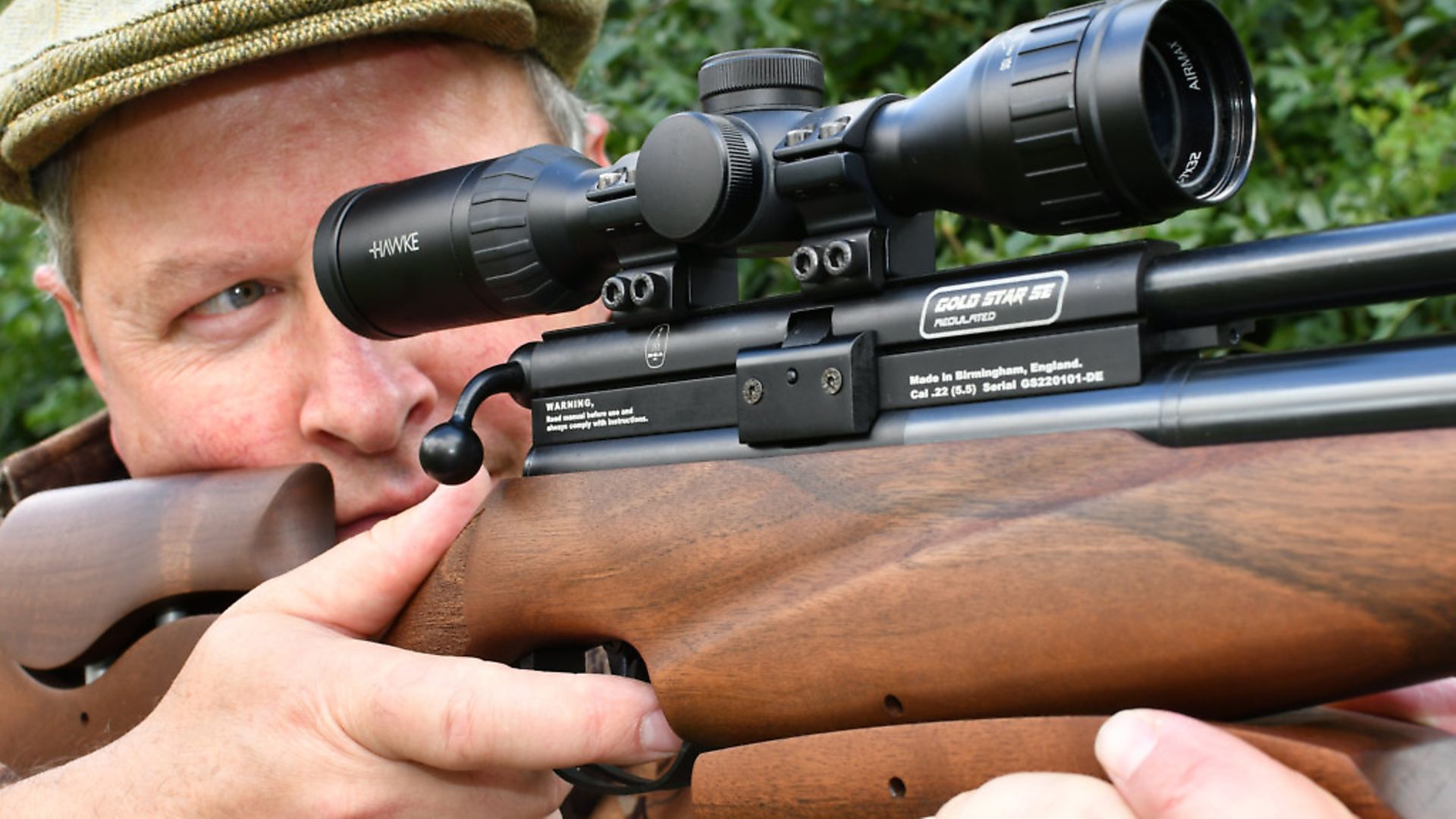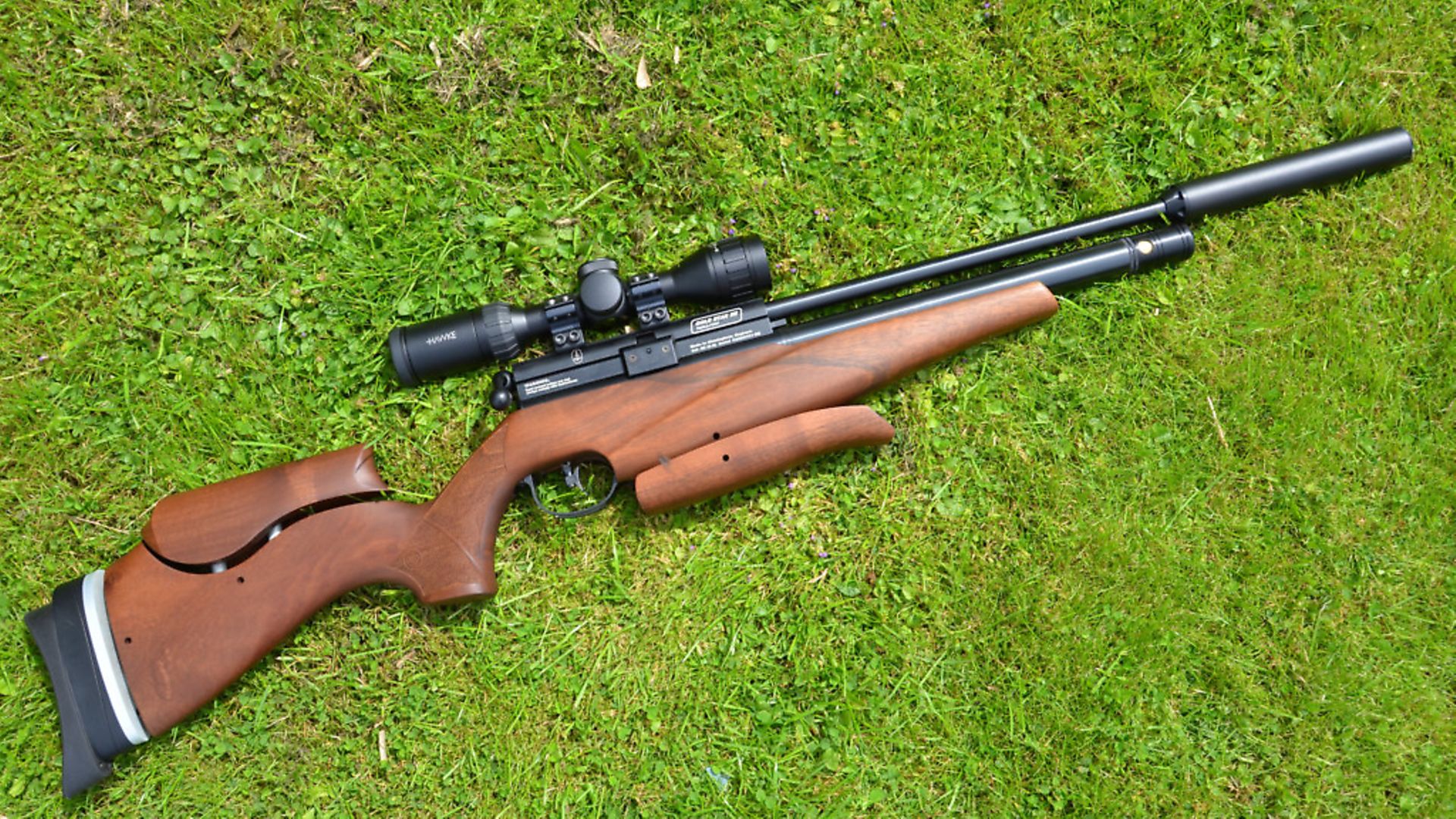Mark Camoccio tries the hunting set up of the lovely BSA Goldstar
 credit: Archant
credit: Archant
As field target shooting – still the flagship airgun sport – became increasingly sophisticated, with full match rigs and huge magnification scopes inevitably dominating results, so a breakaway sport was required, to cater for a different sort of shooter, who just preferred to keep things more straightforward. Hunter Field Target shooting (HFT) appealed to me right from the start. Yes, there are methods used to rangefind targets, but overall, the sport evolved from a move back to more instinctive shooting.
Each to his own, as they say, and it has to be a cause for celebration because both sports now happily co-exist, appealing as they do, to different sections of the airgun community.
Dedicated
When any sport starts to attract dedicated equipment from manufacturers, you know it has well and truly ‘arrived’, and so it is with HFT. Consider the remit for the sport, though; to offer the enthusiast a competition course of knock-down targets, to simulate roughly a real-life hunting scenario, and it soon becomes obvious that the requirements of an HFT rifle should be equally applicable out in the field.
On test here is the Goldstar SE from BSA, a gun designed in conjunction with HFT shooters, with winning in mind, and it’s a classic example of a technical rifle that can double up nicely as a slick hunting machine.
 credit: Archant
credit: Archant
Versatility
As I never tire of saying, personal taste plays a big part in rifle selection, but where BSA scores so highly is in the way the Golds\tar SE follows fairly traditional lines, and yet still offers features aimed at maximising downrange performance. Versatility is clearly the name of the game, so let’s take a look and see what this flagship model has to offer the enthusiast.
Firstly the badging; the ‘Goldstar’, takes its name from BSA’s most successful racing bike of the 1950s, so a nod to the company’s winning ethos of the past, if you like. There’s a choice of three stocks; black pepper (grey/black laminate), red, white and blue (laminate), or traditional, oil-finished walnut. The stocks feature an adjustable butt, cheek piece, and raised fore-end section or ‘hamster’, to coin the silly name. Move to the action and we have BSA’s own ECHF (Enhanced Cold Hammer Forged) barrel fitted; a two-stage trigger, Bolas bolt-action system, regulated action, integral manometer, and even a factory-supplied air stripper. The action can be supplied as a straight single-shot feed, or opt for the multi-shot – and it comes with a ten-shot magazine.
 credit: Archant
credit: Archant
Hunting package
My test rifle was specified in walnut, and as a multi-shot. In keeping with the more hunting bias, it was supplied by BSA with the ‘optional extra’ VC Silencer – ‘VC’ denotes Variable Choke. This silencer model can be adapted to be calibre specific, and in addition to its performance, adds a nice amount of front weight, which I tend to favour.
Back to the stock, and I have to nail my colours to the mast. I just love walnut, and whilst laminate may be technically superior in terms of stability in temperature, the beauty of wood grain sways it for me. Time to prepare, and the first stage, without even firing a shot, has to be setting up the different stock elements, so that the gun fits, and I’m no longer straining to get comfortable.
Start with the butt; first set the length of pull by slackening off the Allen bolts, accessed by the two holes in the stock. With the screws slack, gently slide the butt section in, or pull it out, to the required point. When all feels good, tighten both bolts. Likewise, the butt pad; insert the Allen key into the socket at the rear, and slacken and slide the butt up or down to suit. When the gun mounts into the shoulder and the scope image falls into place naturally, we’ve achieved our goal. The final piece of the stock up for adjustment is the fore-end block. This is designed for HFT, to give sufficient height to take on elevated targets. In a hunting scenario, decide on the position from which most shots will be taken, and set the fore end where it feels comfortable. Again, adjustment is by twin Allen screws, so it isn’t to be adjusted quickly in the field – more a case of ‘set and leave alone’.
More preparation
Fitting a scope is easy with the Goldstar SE, since BSA, unlike some other manufacturers, keep the magazine below the height of the breech block and this allows for a continuous uninterrupted run of dovetail rail. With glassware in place, it’s time to fill the cylinder to the prescribed 232bar; this is usual for BSA, but quite high pressure when compared to many rivals. The air inlet valve sits at the front of the Goldstar’s cylinder, and is accessed by twisting the revolving dust cover, which on my test rifle, was just a little tight.
A probe-style filling adaptor is supplied, and this needs to be screwed onto the airline, from either an airgun pump, or diver’s bottle. Now push the probe into the Goldstar’s valve inlet, charge the cylinder, remove the probe, and twist the cover closed.
Specification:
Model: Goldstar SE multi-shot
Manufacturer: BSA Guns Ltd
Country of Origin: UK
Type: Multi-shot PCP
Calibre: .177, 22 on test, and .25
Weight: 8.2lbs
Overall Length: 35.75 inches with butt closed
Barrel Length: 15.5 inches
Stock: Walnut sporter with adjustable fore end, cheek, and butt
Trigger: 2-stage adjustable
Power source: External bottle or pump
Fill pressure: 232bar
Shot Count: 90 manufacturer’s claim in .22; 75 claimed in .177
Energy: 11-11.5 ft.lbs.
RRP: £899 including mag’, air-stripper, and adapter
Options: Single-shot version £899, Spare mag’ £45, single-shot adaptor £30.80
Contact: BSA Guns
See more PCP tests here...
GRS PCP Sporter Stock
Gamo Phox Silenci